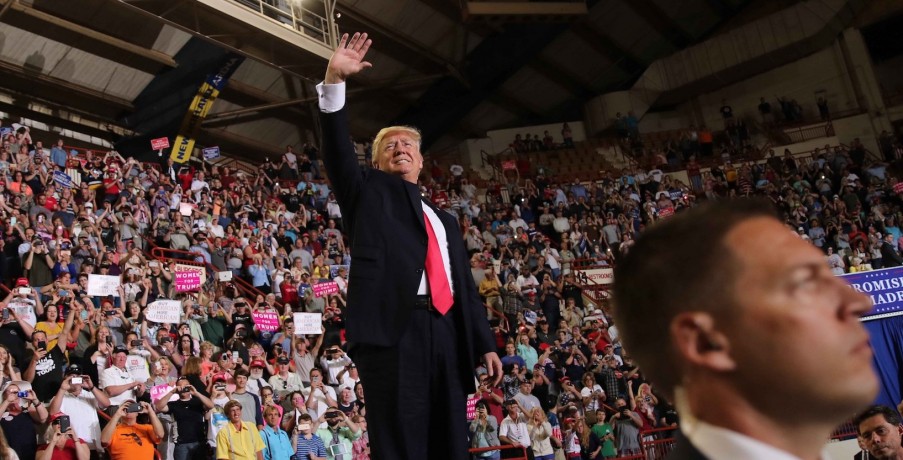
Lee Brice: Garth Brooks is my hero | Kurt's Country
Neil A. Carousso produces NewsNation original “Kurt’s Country” – a celebration of country music and a slice of Americana with host Kurt Bardella.
-
Detailing Trump’s First 100 Days in Office
By Neil A. Carousso
President Donald J. Trump’s 100th day in The White House came on Saturday, April 29. While highly scrutinized in a politically divided time in American history, facing much Democratic “resistance,” President Trump has energized his base, fulfilling many campaign promises, although, no major legislation has been passed through Congress.
Mr. Trump has demonstrated a stark contrast to the past 8 years under 44th President Barack Obama in terms of both domestic and foreign policy. The 45th President has committed to an “America First” agenda to restore blue collar American jobs in the manufacturing sector that have left from the rust belt, renegotiate trade policies to benefit the American worker, cut job-killing regulations and enforce immigration laws, deporting thousands of criminal illegal aliens.
Jobs, Jobs, Jobs
Beginning in the first hours of his presidency, Mr. Trump began cutting regulations imposed by the Obama Administration. President Trump’s philosophy, rooted in traditional conservative ideology, is to pull back on restraints on businesses, especially small businesses, that would allow them to dedicate more time to create outputs and hire more workers.
Under Trump’s pro-business policies, for every new regulation created, two regulations must be repealed.
The former business mogul also signed a House Joint Resolution to help the coal industry recover after strenuous Environmental Protection Agency regulations were imposed. Eight thousand mining jobs were created in February.
About 49,000 manufacturing jobs have been created since new year, according to the Bureau of Labor Statistics, with 12,392,000 U.S. manufacturing employees in the labor force. That is the greatest number of people employed in manufacturing in the United States since January 2009, the month that former-President Obama was inaugurated, when there were 12,561,000 people employed in manufacturing.
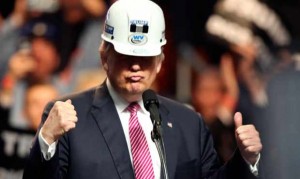
Donald Trump in May 2016, as the presumptive GOP nominee. (Associated Press Photo) In February 2009, manufacturing employment dropped to 12,380,000, a number it did not exceed until February of this year, when it reached 12,381,000.
Construction jobs have also increased in the Trump Administration with 58,000 brick and mortar jobs created in February and another 6,000 in March.
At the same time, according to BLS, the number of people employed in government increased by 9,000 in March, climbing from 22,309,000 in February to 22,318,000.
Since December 2016, the U.S. has gained 49,000 manufacturing jobs and 19,000 government jobs.
In an effort to reduce the Washington bureaucratic machine, President Trump signed an executive order to place a hiring freeze on federal workers, excluding the military and the U.S. Department of Veterans Affairs.
The Chief Executive also placed a 5-year lobbying ban on government employees and a lifetime ban for members of a presidential administration to lobby on behalf of a foreign government.
President Trump signed off on the construction of the Dakota Access and Keystone XL pipelines with the provision to use American-made piping while moving towards energy independence from nations like Saudi Arabia that sponsors terrorism and lives under the oppressive Sharia Law.
In recent weeks, Mr. Trump took steps to undo the Dodd-Frank financial regulations that have slowed bank loans and put pressure on the financial industry at the expense of small financial brokers.
The President with the encouragement of First Daughter Ivanka Trump launched a council for the advancement of women entrepreneurs and has continued to meet with American business tycoons to encourage private sector initiatives to promote women leadership in the workforce.
Since President Trump’s inauguration on January 20, the stock market has grown 12 percent with the Consumer Confidence Index at the highest mark since December 2000. The stock market incline has slowed since House Speaker Paul Ryan, at the direction of the Chief Executive, pulled the American Health Care Act from a House vote on March 24.
Big League Jobs
Since Mr. Trump was elected on November 8, 2016, a number of American companies have made major job announcements to create and save American jobs from leaving the U.S., many after personal pleadings by phone or in meetings with the incoming President. Roughly $110.2 billion in U.S. investments has been pledged with approximately 1,883,830 U.S. jobs being created that can be credited to President Trump’s pro-growth, pro-business policies.
- Carrier: Keeping 1,100 American jobs instead of sending to Mexico
2. SoftBank CEO Masayoshi Son: Investing $50 billion to create 50,000 American jobs
3. Sprint: Bringing back 5,000 jobs to the U.S. that were sent overseas
4. OneWeb (new company): Creating 3,000 jobs in the U.S. (associated with Son’s guarantee)
5. Ford: Cancels $1.6 billion plant in Mexico, saving 3,500 American jobs. Creating new innovative center as an expansion of its Flat Rock, MI plant by investing $700 million in the U.S. and creating 700 American jobs
6. Qualcomm and Apple will invest in SoftBank’s new technology fund, SoftBank Vision Fund that is being used to create 50,000 American jobs.
7. Fiat Chrysler announces it would spend $1 billion on U.S. manufacturing, including modernizing plants in Michigan and Ohio, adding 2,000 new American jobs.
8. Toyota will spend $10 billion in U.S. capital investments and will expand its U.S. plants over the next five years.
9. Alibaba Chief Executive Jack Ma met with Trump to discuss the creation of 1 million American jobs, specifically focusing on small business growth.
10. Amazon will create 100,000 jobs in the first year and a half of the Trump Presidency.
11. Wal-Mart will create 10,000 jobs in the U.S. this year.
12. General Motors will invest $1 billion in its U.S. factories this year, moving some parts of production from Mexico to the United States that was previously handled by a supplier.
13. Toyota will add 400 American jobs to build more SUVs at an Indiana assembly plant.
14. Amgen will add 1,600 jobs.
15. Intel will invest $7 billion in innovation in an Arizona factory, creating 3,000 specialist positions and 10,000 support jobs.
16. Delta announces it will hire 25,000 jobs over the next 5 years.
17. Lockheed Martin will create 1,800 new jobs.
18. Exxon Mobil will invest $20 billion to create 35,000 temporary construction jobs and 12,000 high-wage permanent jobs.
19. Charter Communications will invest $25 billion in broadband infrastructure over the next four years to create 20,000 high-paying, highly beneficial American jobs.
20. Ford will invest $1.2 billion in Michigan, securing 3,700 American jobs and creating 130 jobs.
21. Toyota will invest $1.3 billion to revamp its Kentucky factory, saving 8,200 American jobs.
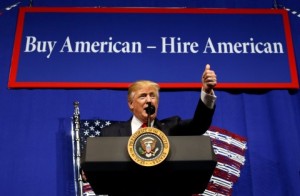
President Trump visited Wisconsin to sign the Buy American, Hire American executive order on April 18 (Kevin Lamarque/Reuters) On day 89 of Trump’s presidency, the first businessman to occupy the Oval Office visited Wisconsin, where he was the first Republican since Ronald Reagan’s re-election to win over the Democrat Party nominee. President Trump announced an executive order, “Buy American, Hire American,” a campaign pledge to mandate American companies use American products and higher American workers before high-skilled foreign workers.
The order targets the H1-B visa program, which permits American companies to employ foreign workers in IT, engineering, mathematics and science industries. Mr. Trump, fulfilling a campaign promise, seeks to end the H1-B lottery system and replace it with a merit-bases system enforcing that foreign workers, hired by U.S. companies, are highly skilled with Americans given priority for jobs.
Since 2009, 95 million Americans left the labor force, the lowest labor participation rate since the 1970s. Thirteen million more Americans are on food stamps with about 43 million Americans living in poverty at the conclusion of the Obama Administration-era.
Peace Through Strength
President Trump plans to seek what he’s calling a “historic” $54 billion increase in defense spending, while pursuing cuts elsewhere in the federal government, as part of his upcoming budget plan. The military has been under a “sequestration,” under the Budget Control Act of 2011, with spending cuts and regulations imposed on the U.S. Armed Forces.
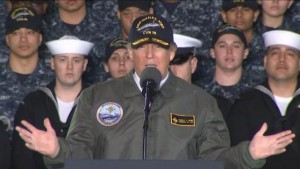
President Trump calls for the largest defense spending budget on March 2 on the deck of the USS Gerald R. Ford in Newport News, Virginia — a brand new carrier that is expected to be commissioned this summer. (Associated Press Photo) President Trump seeks to rebuild the military and the dilapidated military equipment to promote “peace through strength,” an ode to former-President Reagan who had the idea of beefing up the military to discourage other nations from waging war on the U.S.
Across the Armed Forces, the U.S. military equipment has been overused and in many cases part of our fleets and jets have been docked and grounded indefinitely.
Out of 276 F/A-18 Hornet strike fighters in the Marine Corps inventory, only about 30% are ready to fly, according to statistics provided by the Corps. Similarly, only 42 of 147 heavy-lift CH-53E Super Stallion helicopters are airworthy.
U.S. military spending has dropped from $691 billion in 2010 to $560 billion in 2015. The cuts came just as the planes were returning from 15 years of war, suffering from overuse and extreme wear and tear. Many highly trained mechanics in the aviation depots left for jobs in the private sector.
Marine Corps F/A-18 Hornets are supposed to have a shelf life of 6,000 hours, but they are being refurbished to extend the life to 8,000. There is talk that some aircraft might be pushed to 10,000 hours while the Marine Corps waits for the 5th-generation Joint Strike Fighter, which is slated to replace the F-18, but has been plagued by cost overruns.
President Trump has vowed to invest in American ingenuity to strengthen our military in a time of increased terror threats from radical Islamic terror groups. In terms of the budget, the Commander-In-Chief has been personally negotiating for lower prices of the F-35 fighter jets as well as Air Force One, the presidential plane.
Eradicating ISIS from the Face of the Earth
Within weeks of President Trump’s inauguration, he ordered his Defense team including Defense Secretary Gen. James Mattis, and his National Security Council to draw up a plan for defeating the Islamic State that has inspired all-too-frequent terrorist attacks in our country while persecuting and beheading Christians, Jews and journalists overseas and using videos as recruitment propaganda.
Under the guide of the Islamic faith, ISIS militants seek to destroy freedom and the American way of life.
On April 13, the U.S. dropped the “Mother of All Bombs,” a 21,000-pound GBU-43/B Massive Ordnance Air Blast on Islamic State fighters in an area that has been an ISIS stronghold since 2015. According to Afghan officials, the largest non-nuclear bomb with a 1-mile killing radius killed 94 Islamic State militants. While literally destroying ISIS in the region, it sent a message to our adversaries like North Korea that the U.S., under President Trump, will stand-up for American values and will not sit idly by as murderous regimes and extremists murder innocent people.
Shift in Foreign Policy
After campaigning on the idea that America shouldn’t be interfering in other countries’ conflicts, like the Syrian civil war, President Trump had an apparent change of heart after Syrian Dictator Bashar al-Assad launched a chemical weapons attack on his own civilians on April 4.
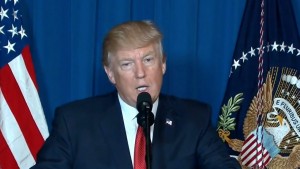
President Trump announced the Syrian airstrike on March 4 at Mar-A-Lago in Florida. (YouTube/White House) “My attitude toward Syria and Assad has changed,” said President Trump at a press conference at The White House Rose Garden alongside King Abdullah II of Jordan. Mr. Trump has spent time on the phone or has met with over 30 foreign leaders, making defeating radical Islamic terror a focal point of all foreign policy meetings.
Trump said, as the leader of the free world, it is imperative for him to remain “flexible” to changing world events.
About 63 hours after Syria heinously attacked its own people, President Trump ordered 59 Tomahawk missiles to be launched, in unison, on an airstrike on the Shayrat airfield in Western Syria, signaling that America will not be isolationists as Assad and his ally in Russia promote and attempt to conceal a vicious attack on civilians.
Chemical weapons have been used in Syria approximately 10 times since 2013, with the Syrian regime responsible for at least half of the attacks.
Former Secretary of State John Kerry and former-President Obama, himself, claimed “100 percent” of chemical weapons were removed from Syria. Since 2013, there have been 10 chemical weapons attacks on Syrian civilians with the Syrian government responsible for at least half of the heinous attacks. Obama infamously drew an unenforced “red line” that would be the Syrian government using chemical weapons.
Helping Our Heroes
On day 89, President Trump signed the “Veterans Choice Program Extension and Improvement Act,” an extension, allowing our U.S. veterans to receive private sector health care, paid by the government.
This will resolve the problematic and outrageous wait times and bureaucracy at the U.S. Department of Veterans Affairs with too many veterans committing suicide while waiting on line. The suicide rate among veterans has surged 35 percent since 2001, driven in part by sharp increases among those who have served since 2001, according to the largest study of such suicides. Of particular concern is the suicide rate among women, which has increased 85 percent in that time.
The veterans choice program was enacted amid the 2014 wait-time scandal. As a result, veterans can seek private health care if they live within 40 miles from a VA site. 1.5 million veterans have made 7 million appointments.
President Trump has promised to reduce the alarming veterans statistics, as an estimated 39,471 veterans are homeless on a given night, according to the U.S. Department of Housing and Urban Development. Mr. Trump vowed to allow vets to seek private health care anywhere in the country for full coverage by the federal government.
Last week, Mr. Trump ordered the opening of a new accountability office of the VA, providing whistleblower protection for Veterans Affairs employees who sound the alarm on inefficiencies and poor treatment of U.S. veterans.
Law and Order
President Trump made immigration a core issue of his campaign for president, proposing a physical wall on the southern border to include increased Immigration and Customs Enforcement (ICE) officers, video surveillance, face recognition and other technological deterrents and border control measures.
The Trump Administration is receiving hundreds of proposals from American construction companies that are applying to build the wall.
The Trump Administration is hiring of 5,000 border patrol agents and 10,000 ICE officers. Plus, Attorney General Jeff Sessions has announced the addition of 125 immigration judges to be able to process and arraign criminal illegal aliens with due process, ending the “catch-and-release” and sanctuary city policies that have enabled the harboring of criminal illegal aliens in minority communities. Sessions has also repeatedly threatened to withdraw funding from cities and states that do not enforce federal immigration law.
Since President Trump’s inauguration, the Department of Justice has published weekly reports of illegal immigrant crime, including detainer requests and deportations that have occurred. The reports reveal that MS-13 gang members from El Salvador, Guatemala, Honduras, Mexico and other countries, who economically thrive on the sale of opioids across the border, have been detained and deported. Murderers, rapists, drug dealers and other violent criminals with convictions have also been targeted, detained and deported from the U.S., as the President created a task force to reduce crime.
President Trump signed an executive order to target drug cartels while there is a violent drug epidemic in the country. Attorney General Sessions has ordered U.S. attorneys to prosecute criminal illegal aliens and drug cartel members to the fullest extent of the law.
In a shift of rhetoric and a signed order, law enforcement officers are being supported and protected. Some states have even followed with “Blue Lives Matter” legislation, increasing penalties for assaulting police officers that has become a cornerstone of the violent anti-Trump and anti-police riots that have swept the nation. The past administration embraced the radical “Black Lives Matter” movement, even protesters to The White House.
President Trump signed two travel suspension orders from radical Islamic terror riddled nations – Yemen, Somalia, Syria, Sudan, Iran and Iraq. Iraq was left off the revised order that was a “watered down version” of the first executive order, according to Trump at a post-inauguration rally in Melbourne, FL. Both have been tied up in the courts as activist judges instituted holds based on Trump’s campaign comment about a “Muslim ban.” These orders, though, did not include the most populous Muslim nation, Indonesia, or other Muslim-majority nations. These six countries fail to communicate about traveler to the U.S. and have been recent hotbeds of terror.
Other Successes
The November 8 exit polls revealed that the Supreme Court vacancy, left by Justice Antonin Scalia when he passed away last February, was a top issue. Of the nearly 700 counties that voted for Obama twice, one-third states flipped to support Trump. The Republican also won 194 of the 207 counties that voted for Obama either in 2008 or 2012.
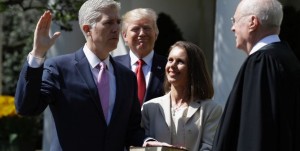
Justice Neil Gorsuch is sworn in as Associate Justice of the Supreme Court of the United States at The White House Rose Garden (Associated Press Photo) On April 10, Justice Neil Gorsuch was sworn in as the 113th Associate Justice on the Supreme Court of the United States with his first day on the Court 8 days later.
Gorsuch is a respected judge who has ruled on a number of religious liberty cases, but not abortion. He is seen as a moderate conservative justice who has ruled under the common Constitutional, originalist philosophy. Justice Gorsuch, 49, is the youngest sitting justice and the youngest to be confirmed since Clarence Thomas at 1991 at the age of 43.
President Trump has also signed executive orders to reduce business and ObamaCare regulations while cutting burdensome EPA regulations on businesses and reducing government bureaucracy.
Mr. Trump is also working across party lines, trying to engage with Democrats where appropriate. Trump has met with Rep. Elijah Cummings (D-MD) and pharmaceutical company CEOs in an effort to lower prescription drug prices.
Mr. Trump is meeting with inner-city leaders, working to implement school choice policies, allowing families to decide where to send their student children to receive an education. The President continues to meet with Congressional Black Caucus members and African American leaders to clean up inner cities after a year of record gang violence and inner-city crime.
Chicago saw 163 murders in 2016 with 786 shooting incidents in the Windy City. The sanctuary city has already seen numbers inch towards the 2016 levels in the fourth month of the 2017 calendar.
A show of patriotism, President Trump signed an order investing in NASA’s space exploration programs.
Challenges and Arguable Shortcomings
Failure to send the American Health Care Act to a House vote was embarrassing for Republicans who have campaigned on “repeal and replace” of ObamaCare for over 7 years. The GOP and President Trump set an artificial deadline to get a 3-pronged approach repeal and replacement plan through legislation, but conservative members of the Freedom Caucus were not in unison with moderate Republicans who seem to be more generous on benefits that would not reduce premiums and deductibles enough to be a major change from Obama’s signature legislation.
At first, President Trump suggested that he would move on to tax reform as the first piece of Congressional legislation to tackle, but the Affordable Health Care Act contains taxes that would ideally be cut before true tax reform can be addressed.
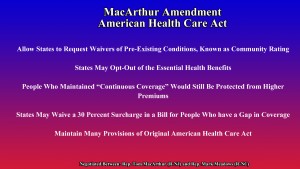
The MacArthur Amendment to the American Health Care Act (“The Neil A. Carousso Show”) The MacArthur Amendment, proposed last Wednesday, to the American Health Care Act maintains many provisions in the original bill, but it would allow states to request waivers of pre-existing conditions, known as community rating. The amended ObamaCare replacement bill allows states to opt-out of the essential health benefits while protecting people with “continuous coverage.” States may waive a 30 percent surcharge in a bill for people who have a gap in coverage. The House Freedom Caucus, the conservative wing of the Republican Party that refused to endorse the AHCA, because it would not lower premium and deductible costs by large enough margins, has endorsed the MacArthur Amendment.
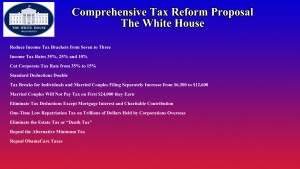
President Trump’s tax reform proposal (“The Neil A. Carousso Show”) There has not been comprehensive tax reform since former-President Reagan’s 1986 tax cuts. Mr. Trump has proposed simplifying the 4 million-word tax code, reducing personal tax brackets to 3 and cutting taxes across-the-board. Trump also aims to reduce the corporate tax rate to 15 percent from 35 percent, the highest among developed nations, and offer incentives for companies to repatriate trillions of dollars stored and invested overseas to invest and create jobs in the U.S. The White House has also proposed a doubling to the standard deductions for middle class individuals and families and elimination of tax deductions except mortgage interest and charitable contributions. The Trump Administration is also seeking to end the estate tax, also known as the “death tax,” repeal the alternative minimum tax and ObamaCare taxes.
Congress, which was only in session 8 days in April, has set an August timetable to have healthcare and/or tax reform passed, but that is looking unlikely at this time, a blow to the ambitious Trump Agenda that requires a fast-moving legislative branch to match Mr. Trump’s unrivaled work ethic.
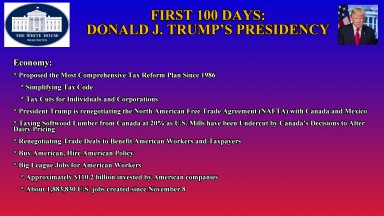
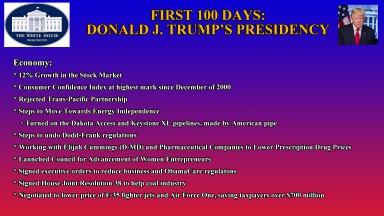
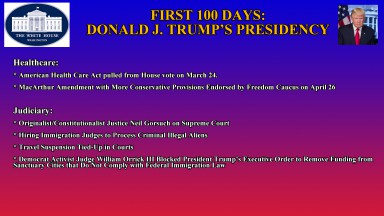
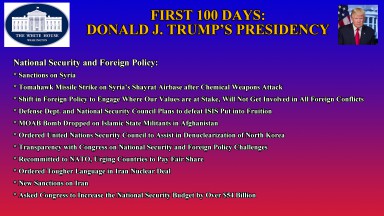
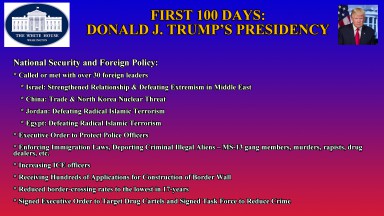
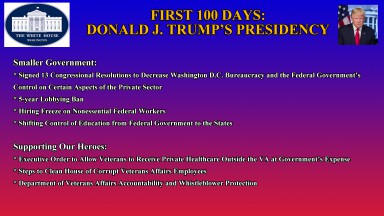 100_Days_1.jpeg100_Days_2.jpeg100_Days_3.jpeg100_Days_4.jpeg100_Days_5.jpeg100_Days_6.jpeg
100_Days_1.jpeg100_Days_2.jpeg100_Days_3.jpeg100_Days_4.jpeg100_Days_5.jpeg100_Days_6.jpeg—
Moving forward, President Trump has about 1,360 days remaining in his first term. While many steps have been made to create change in Washington and implement his ambitious agenda, it will be incumbent upon the Chief Executive to pass legislation through Congress. The President will be ultimately judged on economic results for the market and American workers, keeping the country safe from terror, defeating our enemies, including radical Islam and criminal illegal aliens, and respectably leading the United States in terms of its standing in the world, energy independence, prosperity and peace.
Featured Image Courtesy of Reuters photographer Carlos Barria.
- Carrier: Keeping 1,100 American jobs instead of sending to Mexico


